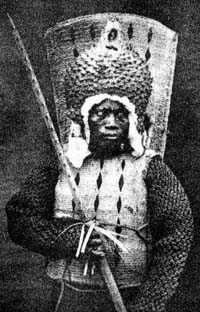You can help expand this article with text translated from the corresponding article in French. (July 2021)Click [show] for important translation instructions.
|
 Nauruan warrior, 1880 | |
| Total population | |
|---|---|
| c. 15,000 | |
| Regions with significant populations | |
| c. 11,000 | |
| c. 800 | |
| 135 [1] | |
| Languages | |
| Nauruan (native), English, Nauru Pidgin | |
| Religion | |
| Christianity, Shamanism, Animism | |
| Related ethnic groups | |
| Polynesians, Melanesians, and Micronesians | |
Nauruans are a nation and an ethnic group indigenous to the Pacific island country of Nauru. They are most likely a blend of Micronesian, Melanesian and Polynesian ancestry. [2]
Contents
The origin of the Nauruan people has not yet been finally determined. It was probably seafaring or shipwrecked Polynesians or Melanesians, who established themselves there because there was not already an indigenous population present, whereas the Micronesians were already crossed with the Melanesians in this area.
The Nauruans have two elements of their population: the native Micronesians and the Polynesians who had immigrated long before. Through these two extremes, diverse traditions came to exist.
In about 1920, influenza spread through Nauru, which took a heavy toll on the Nauruans. In 1925, the first cases of diabetes were diagnosed by doctors. Today, depending on age, every second to third Nauruan is diabetic – a higher rate than any other country in the world.